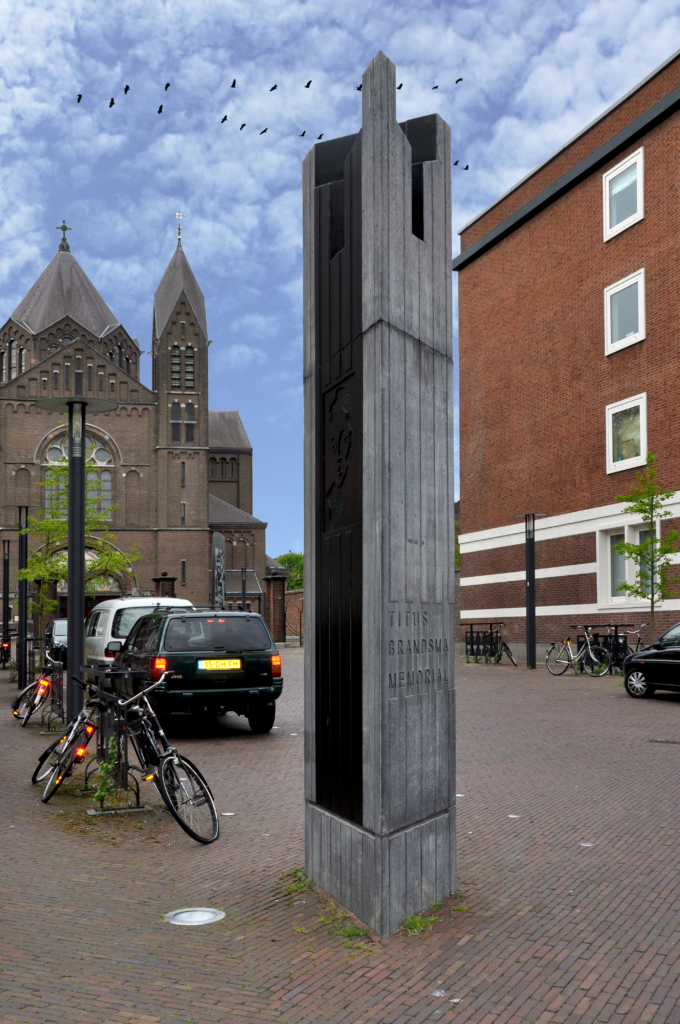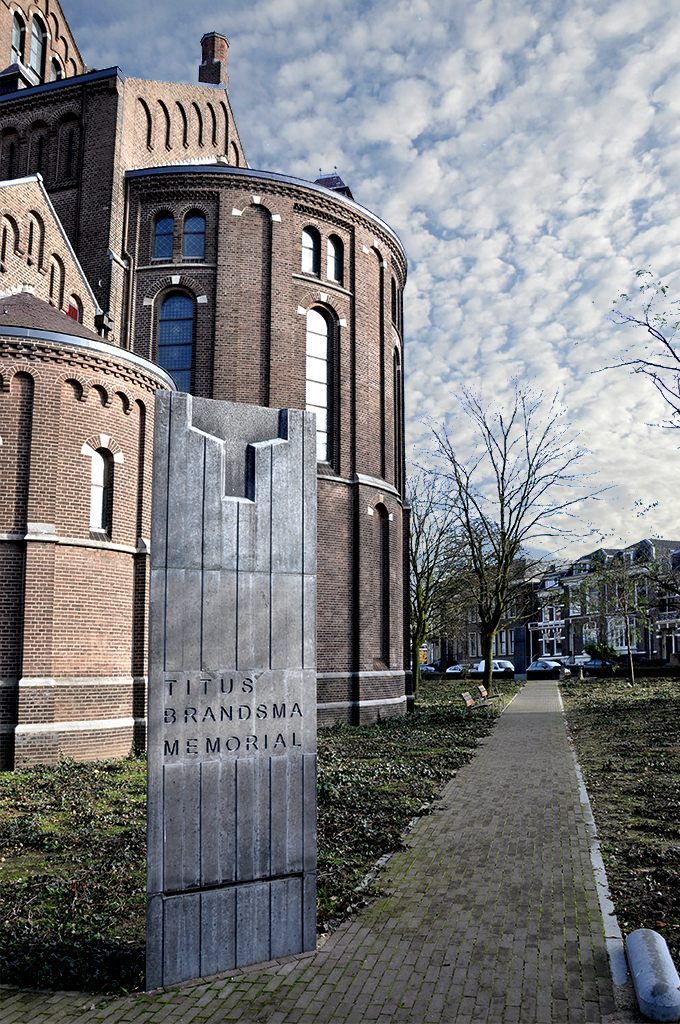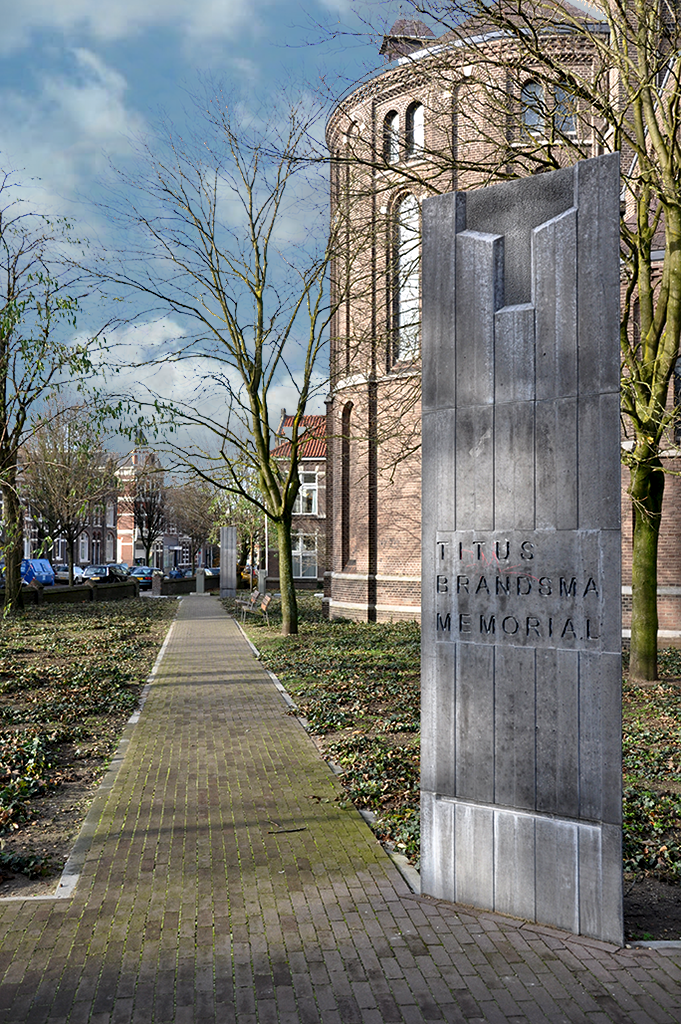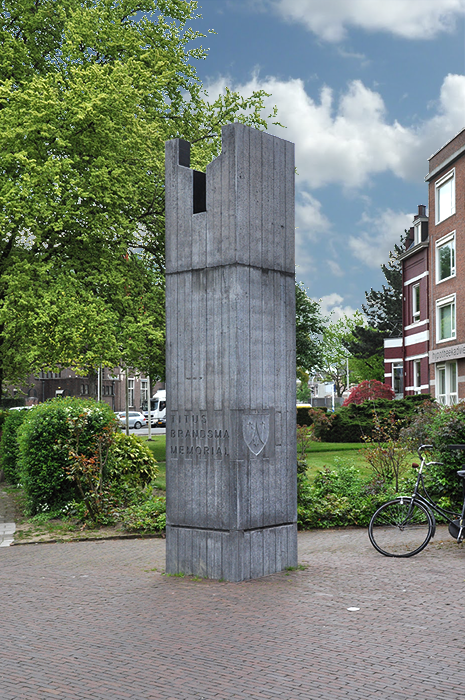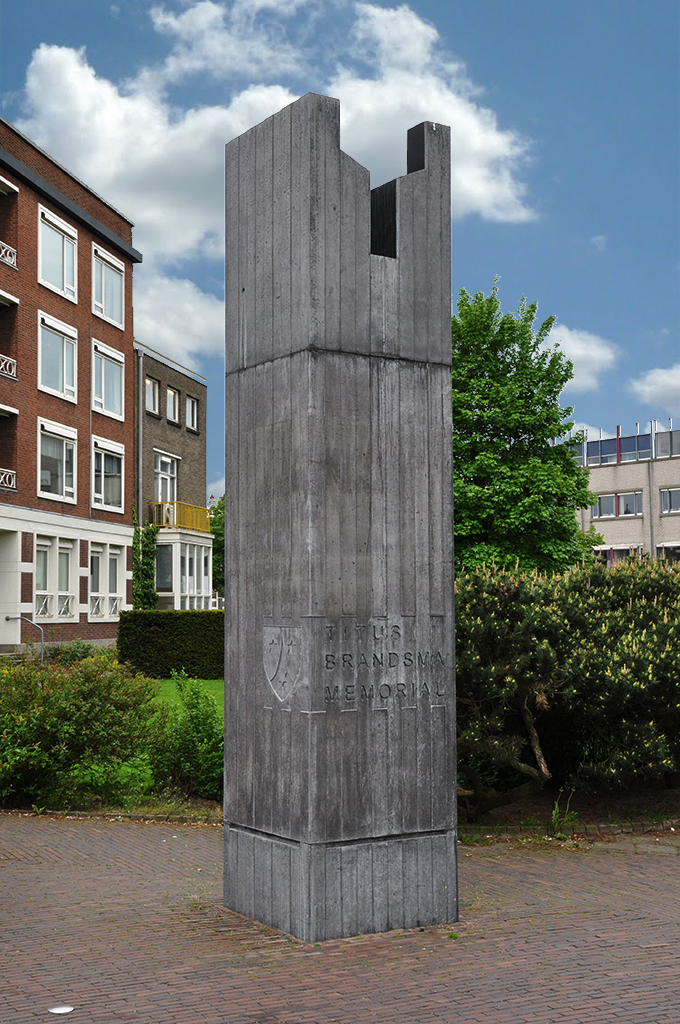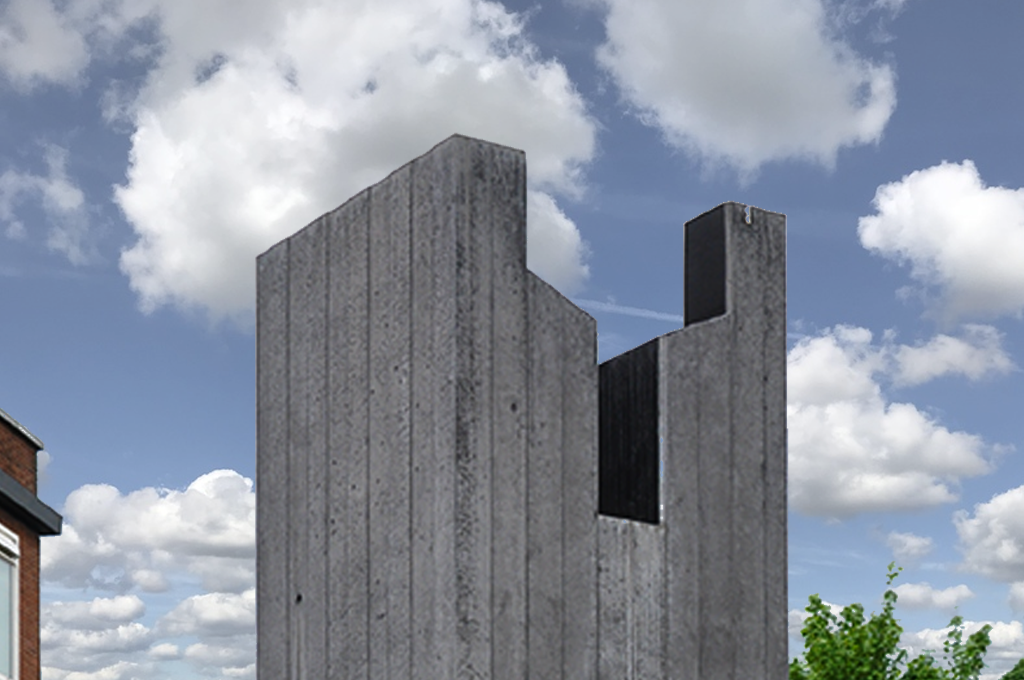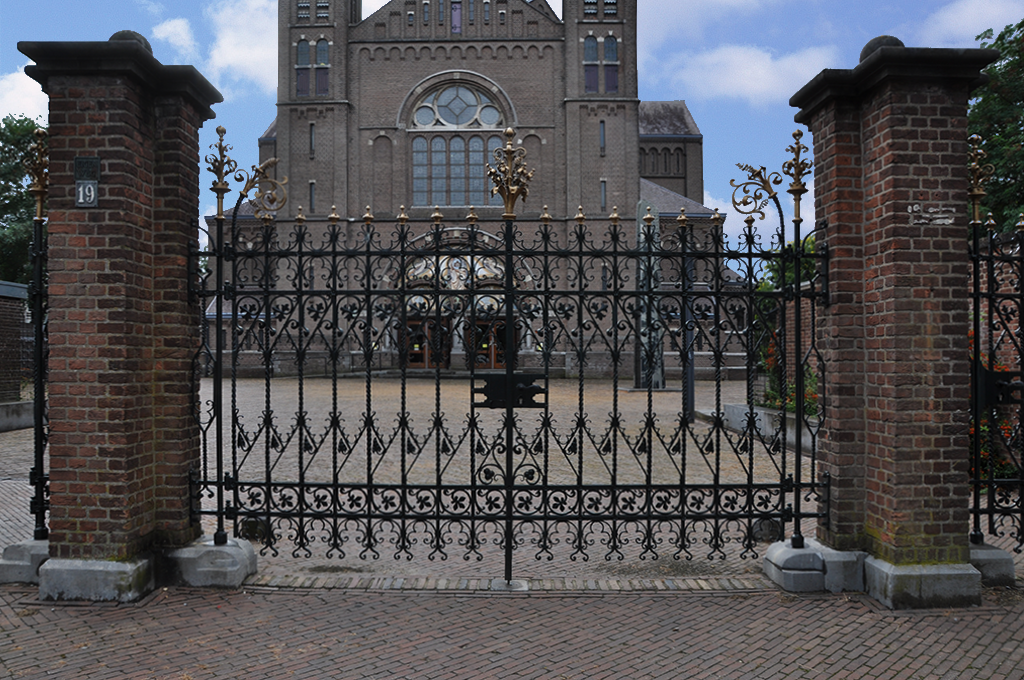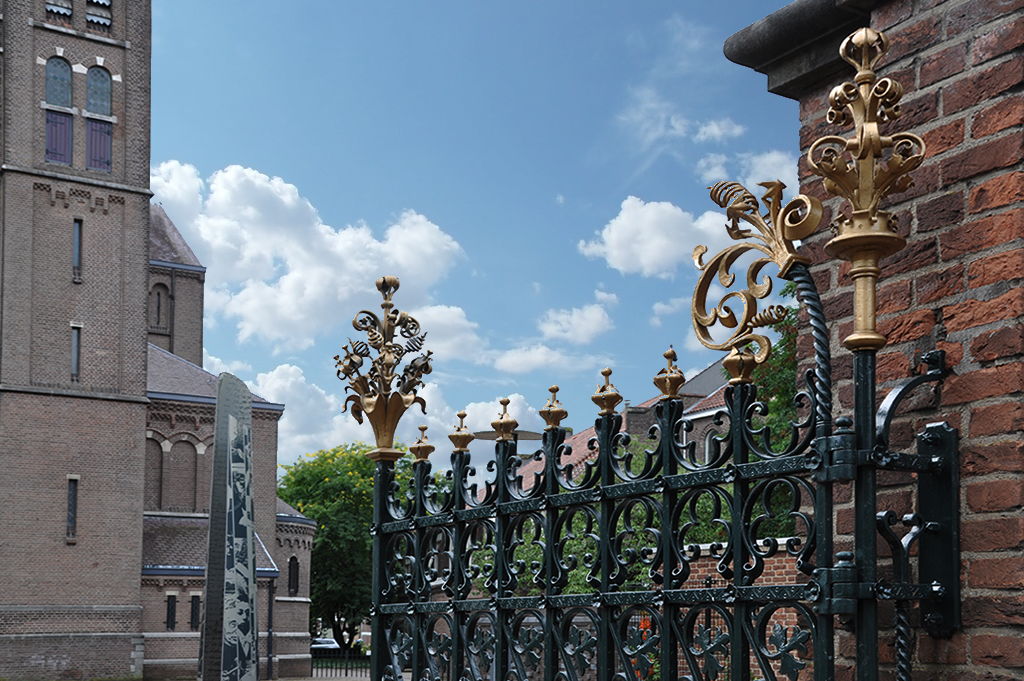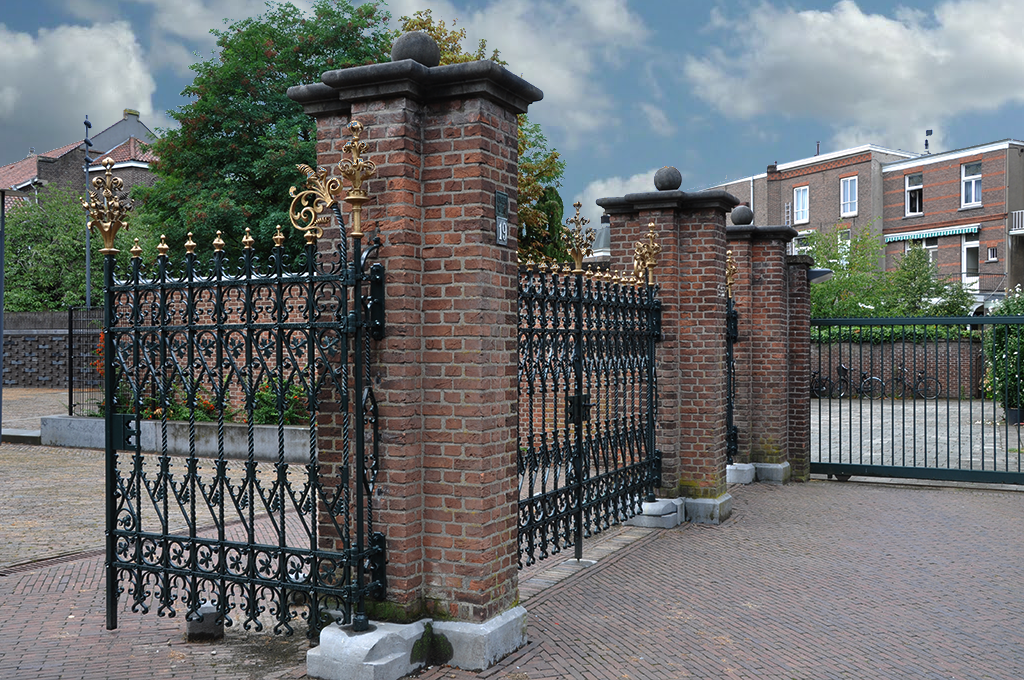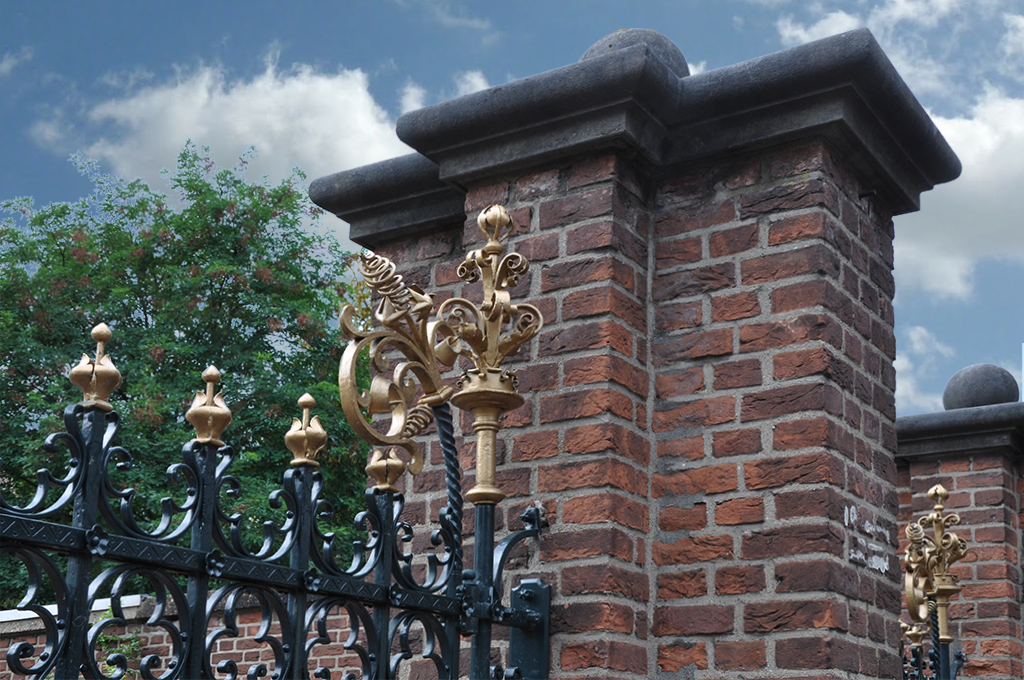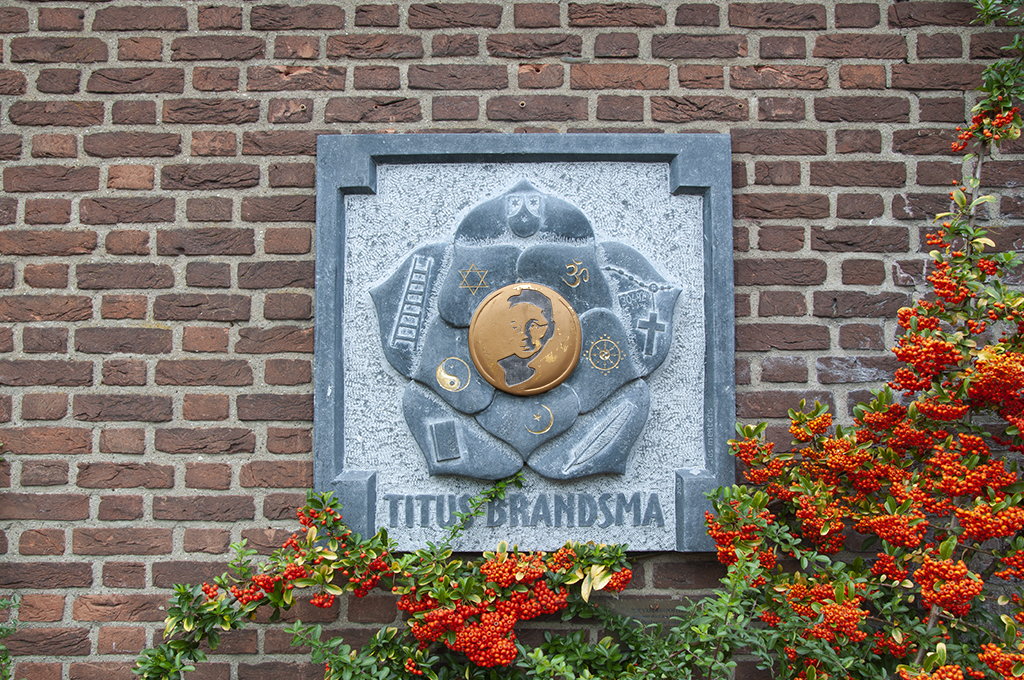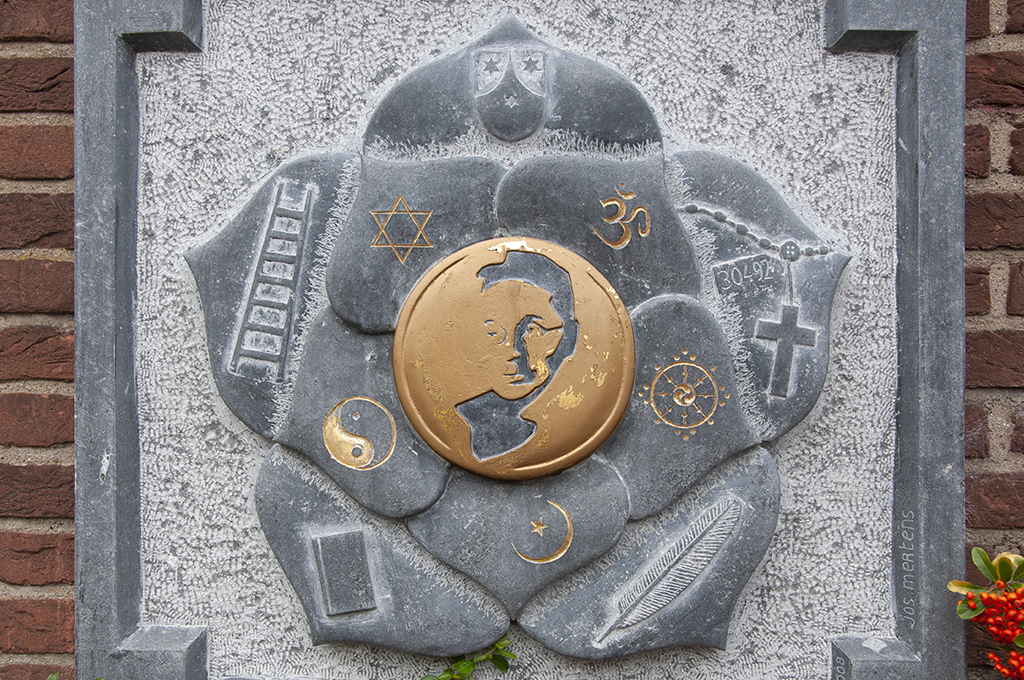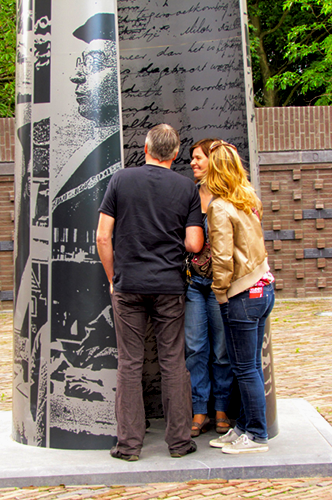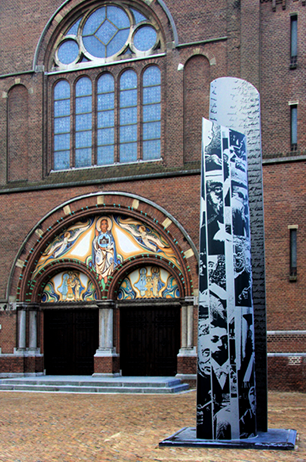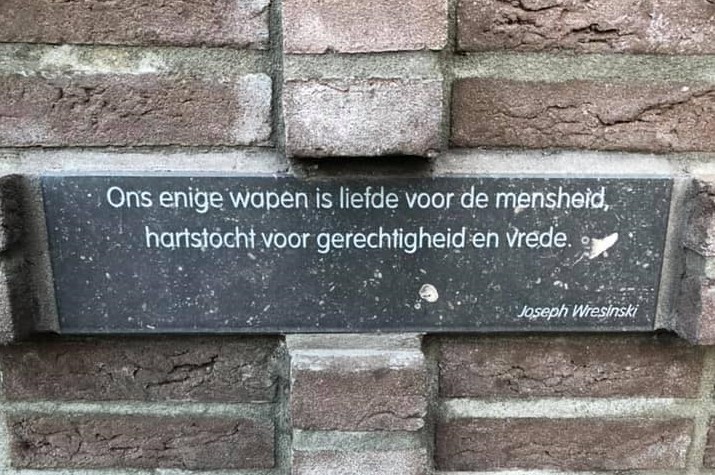
When you walk from the Keizer Karel roundabout towards the Titus Brandsma Memorial Church,
you will first pass two ‘guards’, then you will see fences to the left and right,
with several openings in it in the shape of Tau.
You will then pass the wrought-iron entrance gates, and can see on your right
de plaque for Titus Brandsma, to finally arrive at the Titus court.
Op dit plein loopt u direct tegen het hoge gedenkteken voor Titus Brandsma aan.
Links daarvan ziet u de vredesvlam. Het plein wordt omrand door
de vredesmuur aan de ene kant en de de Karmelmuur aan de andere kant.
Wij willen hier met u langs al deze objecten gaan en van elk de betekenis vertellen,
wie de ontwerper is en wanneer ze geplaatst zijn.

Tough and sturdy, these guards welcome visitors and announce the Titus Brandsma Memorial.
What does the T at the top of the column mean?

The T stands for Tau, the nineteenth letter of the Greek alphabet.
It symbolises life and resurrection.
It is a sign of peace and kindness.

On 12 September 2015, a festive opening celebrated the restoration of the monumental gates of the Titus Brandsma Memorial Church to their former glory. The then alderman for culture of the municipality Ben van Hees opened the gates together with Niek Wouters, a student of the Hooghuis (of which the Titus Brandsma Lyceum is also a part) in Oss, and in the presence of many interested people.
A 5-year project was thus completed. A project of craftsmanship and hard work, led by master blacksmith Otto van Dijk, together with Gerard Damen and pupils of the technical department of Hooghuisschools in Oss. A masterpiece of craftsmanship.
The restoration was carried out in an authentic, traditional manner, based on the guidelines of the National Service for the Preservation of Monuments.
The gates were thus restored as they were once forged. The exact origin of the gates is unknown, but we do know that they were probably made around 1900.

The Greatest Citizen of Nijmegen
On the occasion of the 2000th anniversary of the city of Nijmegen in 2005, Titus Brandsma was elected the greatest Nijmegen citizen of all time.
For this occasion the artist Jos Mertens designed a bluestone plaque (80 by 80 cm) with the face of Titus Brandsma and a symbolic representation of the concepts of peace and tolerance.
The plaque was unveiled by Mayor Thom de Graaf on July 11, 2008.
Speech given by Kees Waaijman: “What is now hidden will be revealed, – but not by me. For that would be inappropriate, for it is not up to me to remove the veil that now hangs over the face of Titus Brandsma…”
The designer
The plaque was made by Jos Mertens, cultural and religious psychologist, furniture maker and sculptor. About his design he says:
‘I tried to portray Titus Brandsma as a charismatic personality. At the same time, I wanted to give form to his striving to find unity between the various contemplative currents and the profane world. Titus Brandsma as a man of words, who had charisma and knew how to touch many people. Titus Brandsma as a man who was able to combine his religious and secular life into a life in which he served as an example to many.’

When you walk from Charles Quint Square past the guards and through the gates, the most striking thing in the square is the memorial to Titus Brandsma. It makes the square the Titus Court. Titus is present. With images from his life, with handwritten texts and as a statue with a reference to Dachau.
In Dachau, the chimney pipes of the incinerators were the abject symbols of absolute evil,
here I wanted to transform the same forms into a monument of remembrance,
in order to render them harmless once and for all and to show that evil does not have the last word.
Arie Trum, the artist who, together with Coen Tuerlings, designed the memorial.
Through the chimney pipe of the incinerator, Titus Brandsma was carried off.
Now the steel pipe is cut in half and children play in between.
The insides of the steel, they are like palms with Titus’ handwriting. The outsides, for all to see the face of Titus, the handwriting of the Living One.
All signs that a tyrant abhors: life, play space, handwriting, face, indelibly a person.T

Arie Trum, one of the designers
“The pylon, the memorial for Titus Brandsma, represents the most dramatic part of Titus’ biography, namely his martyrdom in Dachau and the erasure of that death by means of burning, but at the same time it had to be transformed into a lasting testimony of tolerance and tolerance. Whereas in Dachau the chimney pipes of the incinerators were the abject symbols of absolute evil, here I wanted to transform the same forms into a monument of remembrance, in order to render them harmless once and for all and to show that evil does not have the last word.In my design I started out from a steel pipe that was to be sawn through over its entire length, creating two segments that, turned slightly away from each other, would for the first time allow a glimpse into the interior. That interior gradually became in my mind a metaphor for the interior of Titus, where he transformed the deepest and most vulnerable part of his person into words, thoughts and prayer, his spiritual and mystical heritage.
I chose to compose numerous fragments of his handwriting into a new graphic whole, hoping that the attentive viewer might be touched by a sentence, a single word, and search for its origin.
And to give that shape, graphic images were used in hard and contrasting black and white, radical, confrontational, printed on steel. These images also stand for that other side of Titus: for his intransigence, his resilience, his radicality, his courage.
The pylon invites you to walk around it, to look at it from all sides, each place having its own perspective and form. Sometimes the form seems closed and you see only the outside, the face of Titus, at other times a combination of outside and inside and you can even enter the inside, the inner self to participate in his writing movements, which reflect the stirrings and movements of his mind.”
In the run-up to the new millennium, the WorldPeaceFlame was born. From the five continents of the world, 7 Flames were flown over to Wales. On July 28, 1999, these Flames were united there into one World Peace Flame and it has been spreading around the world ever since.
Since 2010 the World Peace Flame has been burning in Nijmegen.
The very first monument with a permanently burning flame stands opposite the Peace Palace in The Hague. Since then, many monuments have been added at home and abroad. In the Netherlands, there are monuments in Cadzand, Twente, Vlissingen and Venlo, among others. And since October 2010 the World Peace Flame has also been burning permanently in Nijmegen.
Peace begins with yourself
Peace is not about a faraway country or the neighbors across the street. You carry peace within you and you can do things to ensure that you can experience inner peace. From the peace within yourself you can meet others openly and without judgment. This is how we make a world of peace together, by starting with ourselves.
Monthly – on every first Thursday – we meet you and each other around the World Peace Flame. You are very welcome.
The Titus Court is bordered by two walls, behind the World Peace Flame the Peace Wall and behind the memorial the Carmel Wall.
On the stones of the Peace Wall are statements that prompt the visitor to think about what you yourself can contribute to Peace.

Carmel Wall
Carmel Wall
The stones in this wall represent communities and individuals from around the world who express their support for the Titus Brandsma Memorial in this way. Many of them are connected to the worldwide Carmel community.
The prophet Elijah is considered the spiritual father of the Carmel order. His motto adorns the lintel of the wall: Zelo zelatus sum pro Domino exercituum, (With zeal I have striven for the Lord of the powers). This text is found in the Bible in 1 Kings 19.
Are you interested in placing a stone and thus expressing your support for the TBM? Please let us know via: titusbrandsma@karmel.nl
Tile of the General
On October 1, 2010, the Prior General of the Order of Carmelites P. Fernando Milán Romeral placed the first stone in the Carmel wall. This stone symbolizes all those who are committed to Carmel worldwide.


